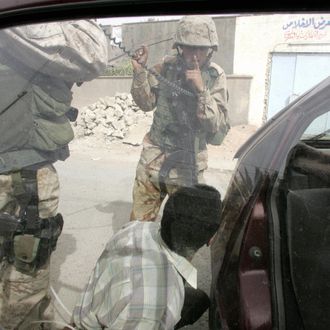
On the same day the U.S. officially ends its war in Iraq, the New York Times runs a front-page story that only begins to touch on the horrors that occurred across the embattled country for the last nine years. In this particular tragic episode, 24 Iraqis, including women, children, and a 76-year-old man, were killed by Marines in the town of Haditha, but new information about the massacre has come to light through the sort of journalism that typically happens only in movies: A reporter happened upon a heap of secret documents, just as they were about to be destroyed.
In a behind-the-scenes account of his A1 story, journalist Michael S. Schmidt tells of getting lost on the way to a junkyard in Iraq and almost opting to turn around and go home. Eventually, he and his team make it inside, where they’re shown a collection of broken-down trailers once occupied by U.S. companies during the war. As Schmidt prepares to leave, something catches his eye:
On the way to the car, I walked past a fire pit and saw a piece of paper on the ground. I picked it up and saw the word “interview” and the name of what appeared to be a Marine. I glanced upward toward the fire pit and saw that there were a few other pieces of paper strewn on the ground, so I went over and picked them up.
Like the other piece of paper, these had the word “interview” at the top. I dug through the trash on the ground, and right next to a well-wishing card to the troops from an American child I found a thick red binder filled with more interview documents. I continued to wade through the trash, picking up every piece of paper I could find. Eventually, I uncovered two maps that were marked classified.
The junkyard guard said he had been burning documents for weeks, and using the fire “to smoke his masgouf, a carp that Iraqis treat as a delicacy.” The papers Schmidt ended up with were the last of the bunch, but they told the story of the Haditha massacre, much to the dismay of the military:
The documents uncovered by The Times — which include handwritten notes from soldiers, waivers by Marines of their right against self-incrimination, diagrams of where dead women and children were found, and pictures of the site where the Marine was killed by a roadside bomb on the day of the massacre — remain classified.
The entire story is worth reading, but as the U.S. declares its time in Iraq over, one particular part of the found testimony seems particularly poignant as a reminder of the daily catastrophes. Here, a U.S. officer explains why no one was moved initially to investigate the 24 dead civilians in Haditha:
“I meant, it wasn’t remarkable, based off of the area I wouldn’t say remarkable, sir,” Mr. Norwood said. “And that is just my definition. Not that I think one life is not remarkable, it’s just — ”
An investigator asked the officer: “I mean remarkable or noteworthy in terms of something that would have caught your attention where you would have immediately said, ‘Got to have more information on that. That is a lot of casualties.’ ”
“Not at the time, sir,” the officer testified.





























